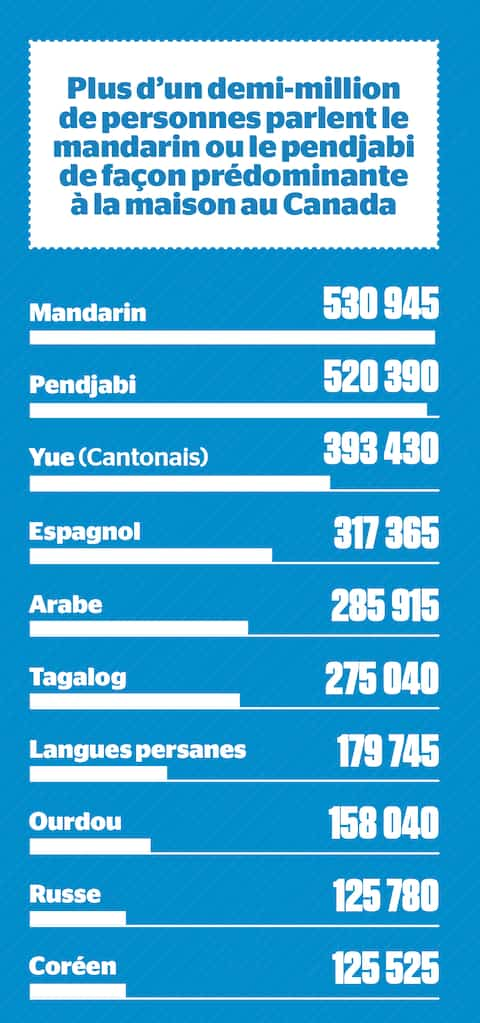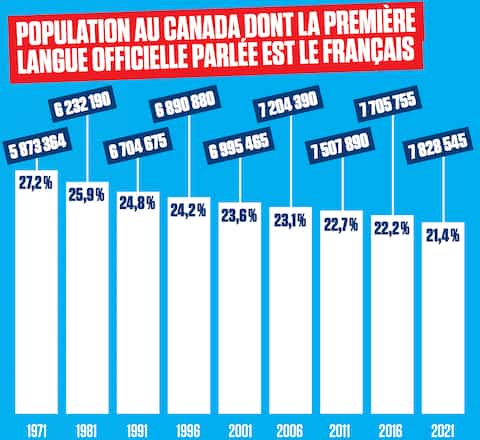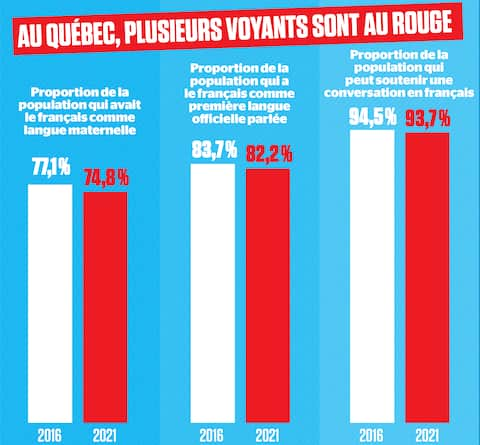The lights are red after the release of Statistics Canada’s 2021 census data, which records the acceleration of the decline of French in favor of English and other languages not only in Canada, but also in Quebec.
• Read also: Decline of French: François Legault finds the situation “worrying”, but not Anglade
• Read also: Montrealers divided over the decline of French
• Read also: 24 declarations of love to the French language
The situation is particularly alarming in the rest of Canada, including Ontario and New Brunswick (see other text).
“It’s quite devastating” for these two provinces, comments the professor at the Royal Military College of Canada Stéphanie Chouinard.
Decline in Quebec
In La Belle Province, French has also fallen on several fronts since the last census in 2016. There has been a decline in the number of people whose mother tongue is French (from 77.1% to 74.8%), the first language official language spoken (from 83.7% to 82.2%) and the predominant language at home (79.0% to 77.5%).
Unsurprisingly, it is on the island of Montreal (-2.4%), Laval (-3%) and Outaouais (-2.4%) that the largest declines in terms of first official language spoken were recorded.
Although it remains relatively high, the percentage of Quebecers who say they are able to carry on a conversation in French has dropped slightly over the past five years, from 94.5% to 93.7%.
Listen to Nic Payne’s column at the microphone of Marc-André Leclerc on QUB radio:
English is progressing
Conversely, the proportion of people with English as their first official language spoken in Quebec is up by one point, now reaching 13.0%, which represents “a return close to the threshold observed in 1981”.
For the first time since comparable data has been compiled, the number of people with English as their first official language spoken passed the milestone of one million speakers in Quebec in 2021.
Statistics Canada explains this increase by the fact that the English-speaking population is younger, by the increase in the number of non-permanent residents and by a slowdown in the exodus of Anglophones to other provinces.
Across the country, “immigration has contributed” to the progression of English since it is towards this language that “a majority of immigrants turn after their arrival in the country”, explains Statistics Canada.
The director of the Demographic and Statistical Observatory of the Francophone Space at Laval University, Richard Marcoux, admits that the situation of French is “fragile” in Quebec, but he is not worried. According to him, the language used at work, and the ability to carry on a conversation in French are the best indicators of one’s vitality.
He believes that the reform of the Charter of the French language of the Legault government is a step in the right direction. A reform that Minister Simon Jolin-Barrette does not intend to strengthen for the moment.
The Minister of Federal Official Languages, Ginette Petitpas Taylor, maintains that “the census data on official languages is worrying”. Remember that the reform of the Trudeau government’s Official Languages Act is still pending.
A portrait of the disturbing Frenchman in the rock
Although the state of French is not encouraging in Quebec, the data from the 2021 Census are even more disastrous in the rest of Canada, particularly in Ontario and New Brunswick.
Across the country, the proportion of people for whom French is the first official language spoken decreased further between 2016 and 2021, dropping from 22.2% to 21.4%, compared to 27.2% in 1971.
Conversely, and for the first time since 1971, English as the first official language spoken has gained almost a point, now reaching 75.5%.
According to Statistics Canada senior analyst Bertrand Ouellet-Léveillé, less than half (49%) of Franco-Ontarians use mainly French at home, while 44% of them speak mainly English there. The remaining 6% use both languages equally.
It is New Brunswick, the only officially bilingual province, which shows the largest drop in people using mainly French (-1.9%).
“It’s worrying for several reasons,” said professor at the Royal Military College of Canada Stéphanie Chouinard, since New Brunswick, land of the Acadians, falls below the “psychological bar” of 30% of people whose first French is official language spoken.
To reverse the trend, “Canada must completely review its immigration system” in order to accept “more immigrants from French-speaking Africa,” judge Professor Richard Marcoux of Laval University.
Population with French as first official language spoken in Canada outside Quebec
- 1971 6.0%
- 1981 4.9%
- 1991 4.6%
- 2001 4.2%
- 2011 3.7%
- 2021 3.3%
Bilingualism on the rise in Quebec, down in the rest of the country
More than ever, bilingualism is above all a matter for French-speaking Quebecers.
In Quebec, the proportion of French-English bilinguals has increased from 44.5% in 2016 to 46.4% in 2021.
During the same period, bilingualism among English-mother-tongue Quebecers fell from 68.8% to 67.1%.
With an overall increase in Quebec of 1.9%, the rate of bilingualism in Canada has remained fairly stable between 2016 and 2021, increasing by only 0.1% to reach 18%.
“This relative stability is in fact the result of two trends moving in opposite directions, the rate of French-English bilingualism having been on the rise in Quebec, but on the decline outside Quebec,” explains the federal agency.
In fact, the French-English bilingualism rate has decreased in the other provinces, going from 9.8% to 9.5%.
“There are serious questions to be asked about the perception and valuation of bilingualism in the country,” believes political science professor Stéphanie Chouinard.
For the first time in history, more than half of Quebecers report being able to carry on a conversation in English.
“This is the first time that this threshold has been crossed since the 1901 Census, when information was collected on knowledge of official languages for the first time,” says Statistics Canada.




